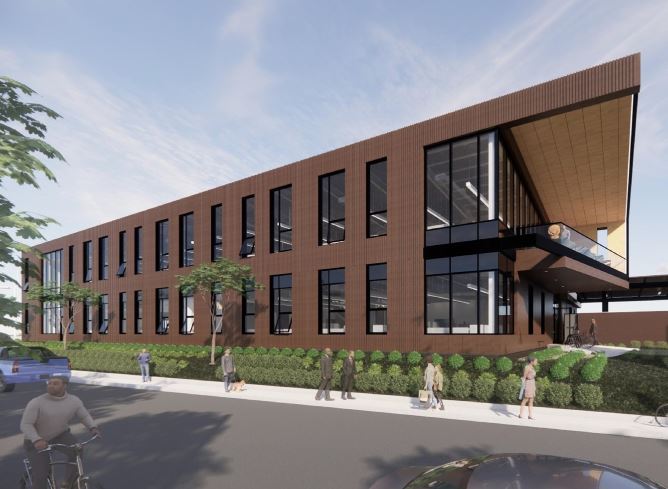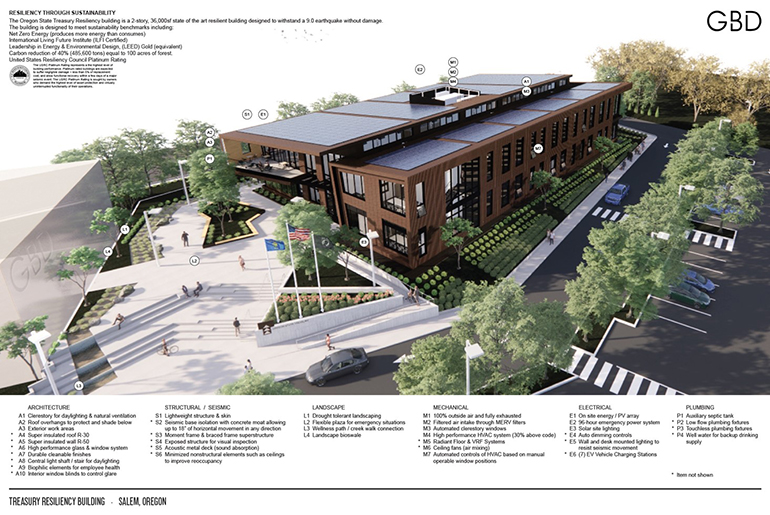
Oregonians have been getting plenty of practice with resilience lately. The pandemic, wildfires, crippling winter storms and power outages: all have tested our perseverance and preparedness.
These challenges have deepened our commitment at Oregon State Treasury to ensuring we have resilient operations. For the past few years, we’ve been making meaningful investments to support continuous operations no matter the circumstances. Next year, we’ll make our biggest move yet: to a new, resilient building able to withstand a Cascadia Subduction Zone earthquake.
The new building, currently under construction in Salem, will allow us to continue meeting the state’s financial needs even after a major catastrophe. Simply put, there’s no building like it in Oregon, and even across the U.S., earthquake-resilient buildings like this are rare. That’s one reason why, in January, the building received a platinum rating from the U.S. Resiliency Council. Here are just some of its features:
- Seismic base isolation and other structural features to help make the building usable immediately after a 9.0 earthquake
- On-site solar energy production with back-up emergency power
- Emergency water and septic systems and water conservation features
- Energy conservation and efficiency measures to reduce overall electric load
- Advanced ventilation and air filtration features
- Data and telecommunications redundancies to support connectivity after a catastrophic event
Treasury won’t own the building, but we’ve negotiated and signed a long-term lease that will contain costs over time. And while this is a big investment for us, we know it will pay dividends for years to come, especially since the building is designed to last 100 years – a long time compared to most new commercial buildings. Strategies that reduce electricity and water use will make the building less expensive to run day-to-day and less demanding during an emergency response. Improved indoor air quality and natural light are also good for employee and visitor health.
Over the last year, we saw how our previous investments can pay off, like when we were able to quickly shift most of our employees to remote work without affecting the services we offer state agencies, local governments, and Oregon individuals and families. On the other hand, the need for further preparedness was laid bare last September, when ash from wildfires affected our computer servers (don’t worry: our response was swift and didn’t impact operations).
While much of Treasury’s work happens behind the scenes, it’s necessary to support the more visible responsibilities of state government. For example, we process hundreds of billions of dollars in banking transactions each year on behalf of state agencies. We move money that gets distributed as retirement checks or SNAP benefits. We oversee investments and bonds for governments across Oregon. The former helps maximize earnings on money that goes on to pay public employees’ salaries or fix a landslide. The latter helps finance large capital projects – like building a bridge or school, or repairing infrastructure after a catastrophic event.
We also receive and distribute federal funds, which Oregon would definitely need as part of any recovery effort.
Ensuring that money still flows through state government in the event of a major emergency is what we call no-fail work – it’s our responsibility to make sure it gets done, no matter what. So we’re taking the next, necessary step to make sure we can meet our responsibilities in good times and bad. We’re just hoping, after all Oregon has seen in 2020 and now into 2021, that we can wait a while before testing out all the building’s features.
Click here to get a full size copy of the photo below.

Return to article selection